SEDE VACANTE 1830-1831
(November 30, 1830—February 2, 1831)
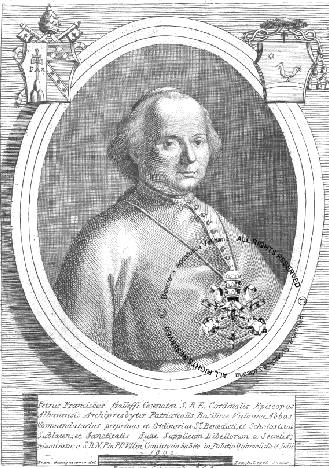
Pietro Cardinal Galleffi
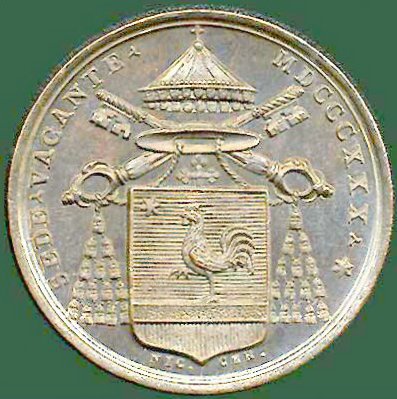 |
AE |
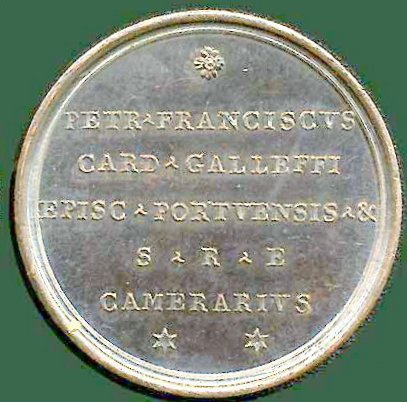 |
|
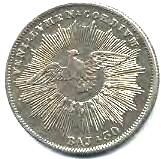 |
AG testone (50 baiocci) VENI • LVMEN • CORDIVM BAJ . 50 The Holy Spirit, surrounded by rays of light. |
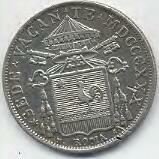 |
SEDE • VACAN TE • MDCCCXXX (in exergue:) • ROMA • Arms of Pietro Francesco Cardinal Galleffi, Camerlengo of the Holy Roman Church, surmounted by the Ombrellone, crossed keys, and the Cardinal's Hat with six tassels on each side. Berman, p. 208 #3272. |
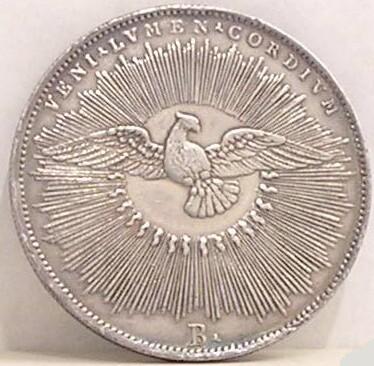 |
AG scudo VENI • LVMEN • CORDIVM B The Holy Spirit, surrounded by rays of light and tongues of fire. |
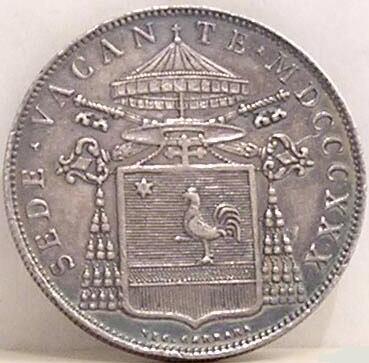 |
SEDE • VACAN TE • MDCCCXXX (in exergue:) NIC • CERBARA • Arms of Pietro Francesco Cardinal Galleffi, Camerlengo of the Holy Roman Church, surmounted by the Ombrellone, crossed keys, and the Cardinal's Hat with six tassels on each side. Berman, p. 208 #3271. |
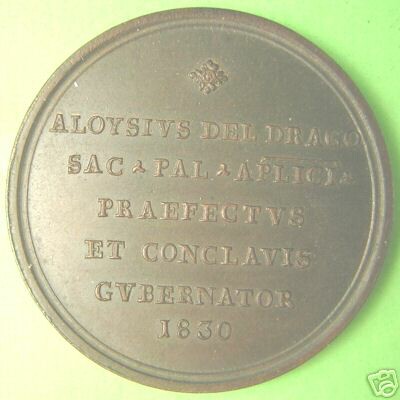 |
AE 30 mm ALOYSIVS DEL DRAGO SAC • PAL • AP(osto)LICI PRAEFECTVS ET CONCLAVIS GVBERNATOR 1830 |
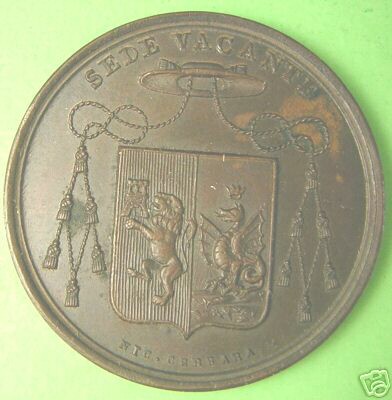 |
SEDE VACANTE NIC • CERBARA Arms of Msgr. Aloysius del Drago, Prefect of the Papal Household, Governor of the Conclave of 1830-31, surmounted by a Clerical Hat with six tassels on each side. Mazio, 906. Spink, #2145. |
CAMERLENGO
Born in 1770 at Cesena, a relative of Pope Pius VI, Pietro Francesco Galleffi was created cardinal on July 11, 1803. He was deported to France in 1809 along with Pope Pius VII; in 1810 he was exiled to Sedan, and only able to return to Italy after Napoleon's exile. He became Archpriest of S. Pietro in Vaticano and Prefect of the Congregation of the Fabric of St. Peter's in 1820, as well as Bishop of Albano. In 1830 he exchanged Albano for Porto-Santa Rufina-Civitavecchia. On December 20, 1824, he became Camerlengo of the Holy Roman Church, a post which he held until his death on June 18, 1837.
The Dean of the Sacred College of Cardinals was Bartolommeo Cardinal Pacca. Born in 1756 at Benevento, Bartolommeo Pacca was the son of Orazio Pacca, Marchese of Matrice, and Crispina Malaspina. He entered the papal diplomatic service and was appointed Nuncio to Cologne in 1785; to carry out that function he was named titular Archbishop of Damiata.
Pacca's difficult mission became an impossible one when the new French Republic invaded the Rheinland; he was transferred to Lisbon. He was created Cardinal priest of San Silvestro on February 23, 1801. In 1808 French troops occupied Rome, and the Pope's secretary of
state, Ercole Card. Consalvi, and his assistants were dismissed; Pacca was appointed pro-Secretary in their places. When Pope Pius VII was arrested by Napoleon in 1809, Pacca was interned at Fenestrelle where he was confined and closely guarded. When the Pope was forced into signing the Concordat of Fontainbleau (January 25, 1813),
Pacca and other cardinals were allowed to join the Pope, but when they proved unaccommodating Napoleon rearrested the Pope and reimprisoned the cardinals. With the fall of Napoleon,
the Pope and his court returned to Rome, where Pacca was immediately named Camerlengo (1814-1824), and, in the absence of Cardinal Consalvi at the Congress of Vienna, he again served as pro-Secretary
of State. He became Cardinal Bishop of Frascati in 1818, then Bishop of Porto and Santa Rufina in 1821, and finally Bishop of Ostia in 1830. He was Camerlengo at the Conclave of 1823. He died in Rome on April 19, 1844.
Msgr. Aloysius (Luigi) del Drago (1776-1845) was Praefectus Sacri Palatii Apostolici (Head of the Papal Household) and Governor of the Conclave of 1830. On September 30, 1831, he was created cardinal in pectore; his name was published as Cardinal Priest of S. Lorenzo in Panisperna on July 2, 1832.
From 1839 to 1845 he was Archpriest of the Basilica of S. Maria Maggiore (Liberian Basilica).
Msgr. Mario Mattei (1792-1870) was Reverendae Camerae Apostolicae Thesaurius Generalis (Papal Treasurer) at the time of the conclaves of 1829 and 1830-31. He became a cardinal deacon on July 2, 1832 In 1843 he was named Archpriest of the Vatican Basilica and president of the Sacred Congregation of the Reverenda Fabbrica di S. Pietro. He became Cardinal Bishop of Frascati in 1844, was translated to Porto and Sta. Rufina in 1854, and became Bishop of Ostia in 1860. He was Dean of the Sacred College of Cardinals from 1860 until his death on October 7, 1870.
Prince Agostino Chigi (d. 1855) was the Marshal of the Holy Roman Church during both interregna, as he had been in 1823. The Prince's diary for the years 1830-1855, Il tempo di Papa-Re, survives, providing some interesting background information on the agonized death of Pope Pius VIII, the Interregnum, and the Conclave of 1831. There were conspiracies and revolts against the papal government in a number of Italian cities, including Rome.
The Governor of Rome (and therefore chief of police) during the two conclaves of 1829-1831 was Msgr. Benedetto Cappelletti (1764-1834). A Benedictine of Monte Cassino, he was essentially a civil and legal administrator, having begun his career in the Apostolic Signatura. He served as papal governor in Viterbo, Macerata (1822), Urbino (1823), and Pesaro. He became governor of the city of Rome in 1829, and held that post until he was named a Cardinal by Gregory XVI on July 2, 1832 as Cardinal Priest of San Clemente.. He was named Bishop of Rieti in 1833, and died there the next year.
The Secretary of the Conclave was Msgr. Paolo Polidori (1778-1847) He began his career as Vicar-General for the Diocese of Viterbo, and then served in the same capacity for the Suburbicarian Diocese of Ostia e Velletri, first for Cardinal Leonardo Antonelli, and then (after an exile from 1809-1814, during the imprisonment of Pope Pius VII) for Cardinal Alessandro Mattei. He was Secretary of Latin Briefs and Secretary of the SC of Tridentine Council. As Secretary of the Consistorial Congregation, he was Secretary of the Conclave of 1829 and the one of 1830-1831. He became a Cardinal on June 23, 1834, and was assigned the titulus of San Eusebio.
The Apostolicis Caeremoniis Praefectus was Dominicus Zucche. The Magistri Caeremonii were: Alexander Lazzarini, basilicae S. Mariae Transtyberim Canonicus; Felix Maria Renazzi, collegii S. Eustachii Canonicus; Matthias Pieri, basilicae Lateranensis clericus beneficiatus; Johannes Baptista Adami, basilicae Lateranensis beneficiatus; and Josephus de Ligne, collegii S. Eustachii Canonicus [Bullarii Romani continuatio 19 , no. LXVII., p. 70].
DEATH OF PIUS VIII
Pius VIII (de' Conti Castiglioni), who had never been in good health, nonetheless maintained a full schedule. On October 31, Solemn Vespers were held in the Cappella Paolina at the Quirinale, with the Pope in attendance. He also participated in the celebration of All Saints' Day in the same Chapel. On Wednesday, November 3, the Pope was present for the Solemn Mass in memory of all the deceased pontiffs, celebrated by Cardinal Falzacappa, Bishop of Albano. On Thursday, the 4th, he was present for the celebration of the Feast Day of S. Carlo Borromeo. and on Friday, November 5, for the Mass in memory of deceased cardinals, celebrated by Cardinal Franzoni in the Capella Paolina at the Quirinal Palace. [Diario di Roma nos. 88-90 (Roma: Cracas 1830)].
But, beginning in November, 1830, he was seriously ill. On the 18th of November, the Pope seems not to have been present at the anniversary of the dedication of the Vatican Basilica. The Diario di Roma of December 2 [no. 96 (Roma: Cracas 1830, p.1], announcing the death of Pius VIII, remarks that he had been ill for thirteen days, beginning on the 17th; this is an understatement. He had fistulas on his neck and his knee, and his entire body was covered with pustules. They got into his chest and he began to suffocate. His doctors were able to bring the secretions under control by November 15, but the Pope continued to suffocate. On the 23rd, things were sufficently serious and sufficiently public that Cardinal Zurla ordered the special prayers pro Summo Pontifice infirmo to be said in all the churches. After three bad nights with what was officially called asthma, at 14:00 hours (Roman time) on Tuesday, the 28th, the Pope was given the Viaticum. On the same day, at 21:30 (Roman time) he was given Extreme Unction by Msgr. Augustoni, titular Bishop of Porfirio, the Papal Sacristan. Then the Fathers-General of the mendicant orders were admitted, to administer special indulgences for members of their orders. The Cardinal Major Penitentiary, Cardinal de Gregorio, also appeared, to carry out his traditional function of assisting at the death of a pope [Diario di Roma of December 2 , no. 96 (Roma: Cracas 1830), p.1]. He died on Thursday, November 30, 1830, at the age of sixty-nine [Petruccelli, 390]. He had reigned one year and eight months.
Next morning, December 1, 1830, having been officially informed of the death of the Pope, the Cardinal Chamberlain, Cardinal Pietro Galleffi, summoned the members of the Tribunal of the Apostolic Camera, and proceeded at 17:00 hours (Roman time) to the Quirinal Palace. After prayers, the face of the body was uncovered, and the Cardinal officially noted the death of the Pope. The De profundis was recited, and the Apostolic Notary, Secretary of the Camera Apostolica, read out the Rogito (death certificate). The Fisherman's Ring was handed over to the Camerlengo by the Maestro di Camera, Msgr. Pandolfi-Alberici. Passing into one of the antechambers, the Camerlengo gave orders that the great bell of the Capitol should be rung to inform Rome of the death of the Pope. He then returned to the Palace of Montecitorio.
On the same evening, Cardinal Pacca, Dean of the Sacred College of Cardinals, held a meeting of the Cardinals who were heads of each order of cardinals, Dandini for the Cardinal Priests and Albani for the Cardinal Deacons, as well as Cardinal Galleffi the Camerlengo, and Msgr. Polidori, the Secretary of the College of Cardinals. They made the immediate practical arrangements for the funeral of the Pope. At the same time, the body of the late pope was being opened and enbalmed.
On the morning of December 2, the remains of the late Pope lay in state in the Cappella Paolina of the Quirinal Palace, with the Penitentiaries of the Vatican Basilica reciting the Office of the Dead. On December 3, at sunset, the praecordia of the late Pope in a mortuary jar were transferred by Msgr. Luigi Bertazzoli to the Church of S. Vincenzo ed Anastasio, the parish church of the Quirinale. The enbalmed body was transferred in procession to the Apostolic Palace of the Vatican, and placed in the Sistine Chapel.
Considerations
The Conclave of 1830-1831 took place in the context of revolution, in Paris (where Charles X was replaced by Louis Philippe), in Belgium, in Poland, in Ireland, in Modena, Parma, and Bologna, in Göttingen, and elsewhere. At the General Congregation meeting on December 5, 1830, the Dean of the College of Cardinals, Cardinal Bartolommeo Pacca, presented a letter which had been placed in his hands by the recently deceased pope, in which, at the pope's direction, the Secretary of State Cardinal Albani (former Nuncio in Vienna) had written to the Austrian general at Verona, inviting him to move his troops up to the border of The Legations (the Papal States) to be prepared to intervene in seditious activities (Lector, 394-395).
The political situation in Italy was also cause for concern in some circles. Prince Clemens von Metternich, the Austrian Chancellor, had already written in some alarm to his diplomatic Chargé in Lombardy, the Count de Bombelles:
So far as regards the interior situation of the Peninsula, Italy is without doubt the one, among all the countries of Europe, in which there is the greatest tendency to revolutions, that is to sya, to accept forms of government liberal in the worst sense. In general, Italy has been materially prepared for these tendencies through the fall of all her ancient institutions, restored only in part or in name; and the desire of the Italians to obtain an independence free from all foreign influence—a desier which for one thousand years has not been satisfied—had taken possession today, more than ever before, of many minds. So that the tranquillity of the greatest part of Italy unfortunately cannot have but little guarantee external to the national character. Its inhabitants, in sum, demand another state of things and independence.
On November 8, 1830, the King of the Kingdom of the two Sicilies, Francesco I, the nephew of Marie Antoinette and Louis XVI, had died; he was succeeded by his son, Ferdinando II (1830-1859). The very lavish funeral took place in Naples on November 17 and 18.
The opening of the Conclave was preceded by an extraordinary incident. On the 10th, about 400 people gathered in one of the Vatican courtyards, broke into the arsenal and seized weapons. They freed the political prisoners who were imprisoned by the papal government. The city was in an uproar. But one of the conspirators revealed what was going on to the police, and arrest of about twenty persons took place on December 11. They were deported to Florence. One of the conspirators, the son of Jerome Bonaparte was claimed by the Russian minister, on the grounds that he was the son of a Princess of Wurtemberg. (Petruccelli, 399, from a dispatch of the Marquis de Crosa). At the eighth General Congregation of the College of Cardinals on December 11, the Cardinals were informed by Msgr. Cappelletti, the Governor of Rome, that there was a conspiracy in Rome itself, in which the Bonaparte nephews of Cardinal Fesch were deeply involved (Lector, 195-196). The cardinals wanted Fesch to persuade his nephews to leave Rome. Fesch refused. The conclave began in a state of highest tension and suspicion.
The Cardinals
An official list of Cardinals and their Conclavists is given in the motu proprio Nos Volentes of Gregory XVI, of December 22, 1831 [Andreas Barberi (ed.), Bullarii Romani continuatio 19 (Romae 1856), no. XXII., pp. 70-72; see also pp. 75-76]. A list of the forty Cardinals who entered the Conclave on the opening day is given by Msgr. Dandalo in Silvagni (pp. 26-27). Pius VIII had created six cardinals: Nembrini, Crescini, Weld, Mazio, De Simone, and Rohan, none of whom had any influence with the other electors. He had named eight cardinals in petto, but their appointments became void on his death. In the twenty months since the last Conclave, the following Cardinals had died: Somaglia, Castiglioni, Bertazzoli, Firrao, Clermont Tonnerre, La Fare, Vidoni, Leoni, and Crescini. There were therefore fifty-four living cardinals at the beginning of the Conclave. Cardinal Pietro Gravina of Palermo had died during the Sede Vacante, on December 6, 1830. Eight non-Italians took part: Croy, Fesch, Isoard, Rohan, Marco y Catalan, Ribera, Gaisruck and Weld (Nova Scotia). The positions and preferences of the cardinals were substantially the same as in 1829. A list of the forty-five cardinals who sooner or later took part is given by David Silvagni (La corte, 429-430). A similar list of living cardinals at the time of the election of Gregory XVI is produced by Giovanni Berthelet (pp. 43-44).
- Bartolommeo Pacca (aged 74), Suburbicarian Bishop of Ostia and Velletri (died 1844) Archpriest of the Lateran Basilica.
- Pietro Francesco Galleffi (aged 60), Suburbicarian Bishop of Porto and Santa Rufina (died 1837) Archpriest of the Vatican Basilica. Abbot Commendatory of Subiaco.
- Tommaso Arezzo (aged 74), Suburbicarian Bishop of Sabina (died 1833) Legate in Ferrara.
- Emmanuele de Gregorio (aged 72), Suburbicarian Bishop of Frascati (died 1839). Major Penitentiary
- Gianfrancesco Falzacappa (aged 63), Suburbicarian Bishop of Albano (died 1840).
- Carlo Maria Pedicini (aged 59), Suburbicarian Bishop of Palestrina (died 1843).
- Luigi Ruffo-Scilla (aged 81), Cardinal Priest of San Martino ai Monti (died November 17, 1832) Archbishop of Naples.
- Joseph Fesch (aged 67), Cardinal Priest of Santa Maria della Vittoria (died 1839) Archbishop of Lyon
- Carlo Oppizzoni (aged 61), Cardinal Priest of San Lorenzo in Lucina (died 1855) Archbishop of Bologna.
- Giuseppe Morozzo della Rocca (aged 73), Cardinal Priest of Santa Maria degli Angeli (died 1842) Bishop of Novara.
- Benedetto Naro (aged 86), Cardinal Priest of San Clemente (died 1832). Archpriest of the patriarchal Liberian basilica (S. Maria Maggiore).
- Giorgio Doria-Pamphilj (aged 58), Cardinal Priest of Santa Cecilia (died 1837). Prefect of the S.C. of Indulgences and Sacred Relics.
- Fabrizio Sceberras Testaferrata (aged 73), of Malta, Cardinal Priest of S. Pudenziana (died 1843) Bishop of Senigaglia.
- Antonio Pallotta (aged 61), Cardinal Priest of San Silvestro in Capite (died 1834).
- Ercole Dandini (aged 71), Cardinal Priest of Santa Balbina (died 1840).
- Carlo Odescalchi (aged 46), Cardinal Priest of SS XII Apostoli (died 1841). Prefect of the S.C. of Bishops and Religious. Leader of the Zelanti
- Giacinto Placido Zurla di Crema, OSB Cam.(aged 61), Cardinal Priest of Santa Croce in Gerusalemme (died 1834). Vicar-General of His Holiness for Rome. Prefect of the Sacred Congregation of Studies
- Giovanni Battista Bussi (aged 76), Cardinal Priest of San Pancrazio (died 1844). Archbishop of Benevento.
- Karl Kajetan Gaisruck (aged 61), Cardinal Priest of San Marco (died November 19, 1846). Archbishop of Milan
- Ludovico (Luigi) Micara, OFM Cap. (aged 55), Cardinal Priest of Santi Quattro Coronati (died 1847).
- Gustave-Maximilien-Just de Croy (aged 57), Cardinal Priest of Santa Sabina (died 1844). Archbishop of Rouen, France. While still in Rouen, his residence had been attacked by a mob, and the National Guard was able to restore only with difficulty He entered the Conclave on Sunday, January 9 [Diario di Roma 3 (1831), 1. Ami de la religion 66 (1831) 358 (Tuesday, December 25)].
- Mauro (Bartolommeo Alberto) Cappellari, OSB Cam. (aged 65), Cardinal Priest of San Callisto (died 1846). Prefect of the S.C. de Propaganda Fide. On November 12, 1830, he had been elected an honorary member of the Academy of S. Luca.
- Jean-Baptiste-Marie-Anne-Antoine de Latil (aged 69), Cardinal Priest of San Sisto (died 1839). Archbishop of Reims, France.
- Pietro Caprano (aged 70), Cardinal Priest of SS. Nereo ed Achilleo (died 1834). Secretary of the S.C. de Propaganda Fide
- Giacomo Giustiniani (aged 60), Cardinal Priest of SS. Marcellino e Pietro (died 1843). Archbishop-Bishop of Imola.
- Vicenzo Macchi (aged 60), Cardinal Priest of SS. Giovanni e Paolo (died 1860). Legate in Ravenna. Doctor in utroque iure
- Giacomo Filippo Fransoni (aged 55), Cardinal Priest of Santa Maria in Aracoeli (died 1856)..Doctor in utroque iure Former Nuncio in Portugal (1823-1828)
- Benedetto Colonna Barberini di Sciarra (aged 42), Cardinal Priest of Santa Maria sopra Minerva (died 1863). Prefect of the Household of Pope Leo XII..
- Giovanni Antonio Benvenuti (aged 65), Cardinal Priest of SS. Quirico e Giulietta (died 1838). Bishop of Osimo and Cingoli.
- Ignazio Nasalli-Ratti (aged 80), Cardinal Priest of Sant' Agnese fuori le mure (died December, 1831).
- Joachim-Jean-Xavier d'Isoard (aged 64), Cardinal Priest of San Pietro in vincoli (died 1839). Archbishop of Auch. He left Auch on December 20 [Ami de la religion 66 (1831) 406 (Thursday, December 30)]. He carried the Instructions of the new French government [Ami de la religion 66 (1831) 295 (Tuesday, December 14)].
- Antonio Domenico Gamberini (aged 60), Cardinal Priest of Santa Prassede (died 1841). Bishop of Orvieto.
- Cesare Nembrini Pironi Gonzaga (aged 62), Cardinal Priest of Santa Anastasia (died 1837). Bishop of Ancona and Numana.
- Thomas Weld (aged 57), Cardinal Priest of San Marcello (died 1837). He had had a serious accident in October, his horse falling on him and crushing his leg; he was in bed for more than a month, but did not suffer complications [Ami de la religion 66 (1831) 326-327 (Saturday, December 18)].
- Raffaele Mazio (aged 65), Cardinal Priest of Santa Maria in Trastevere (died 1832)
- Louis de Rohan Chabot (aged 42), Cardinal Priest of Sma. Trinità al Monte (died 1833)
- Giuseppe Albani (aged 80), Cardinal Deacon of Santa Maria in Via Lata (died 1834) Secretary of State of Pius VIII. Librarian of the Biblioteca Apostolica Vaticana, Archivist of the Holy Roman Church.
- Agostino Rivarola (aged 72), Cardinal Deacon of Santa Maria ad Martyres (died 1842).
- Cesare Guerrieri-Gonzaga (aged 81), Cardinal Deacon of San Adriano al Foro (died 1832).
- Antonio Maria Frosini (aged 79), Cardinal Deacon of Santa Maria in Cosmedin (died 1834).
- Tommaso Riario-Sforza (aged 49), Cardinal Deacon of Santa Maria in Domnica (died 1857). Legate in the province of Forlì.
- Tommaso Bernetti (aged 51), Cardinal Deacon of San Cesareo in Palatio (died 1852). Secretary of State of Leo XII.
- Belisario Cristaldi (aged 66), Cardinal Deacon of Santa Maria in Portico (died February 25, 1831). former Treasurer of the Apostolic Chamber. Doctor in utroque iure
- Juan Francisco Marco y Catalán (aged 59), Cardinal Deacon S. Agata in Suburra (died 1841) former Vice-Chamberlain of the Apostolic Chamber.
- Domenico de Simone (aged 61), Cardinal Deacon of Sant' Angelo in Pescheria (died 1837).
- Cesare Brancadoro (aged 73), Cardinal Priest of S. Agostino (died 1837) Archbishop of Fermo. Uncle of Card. Bernetti. (He was already blind).
- Rudolf Johannes Joseph Rainier von Habsburg-Lotharingen (aged 43), Cardinal Priest of San Pietro in Montorio (died July 24, 1831). Archduke of Austria, Archbishop of Olmütz
- Patricio da Silva, OESA (aged 74), Cardinal Priest without title (died 1840). Patriarch of Lisbon
- Carlo Vittorio Ferrero della Marmora (aged 73), Cardinal Priest without title (died December 30, 1831). former Bishop of Saluzzo
- Pedro de Inguanzo y Rivera (aged 66), Cardinal Priest of San Tommaso in Parione (died 1836). Archbishop of Toledo
- Francisco Javier de Cienfuegos y Jovellanos (aged 54), Cardinal Priest without titulus (died 1847). Archbishop of Seville
- Alexander (Sándor) von Rudnay und Divékújfalusi (aged 70), Cardinal Priest without titulus (died September 13, 1831). Archbishop of Esztergom
- Bonaventura Gazzola, OFM Ref. (aged 86), Cardinal Priest of San Bartolommeo all' Isola (died 1832). Bishop of Montefiascone and Corneto.
- Giovanni Caccia-Piatti (aged 80), Cardinal Deacon of SS. Cosma e Damiano (died 1833).
POLITICAL THOUGHTS
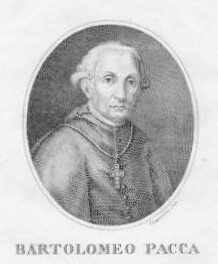
Luigi Carafa, the representative in Rome of the Neapolitan government, was sending regular dispatches to the Prince of Cassaro about developments in Rome consequent upon the death of Pope Pius. He observed that the Neapolitan government would have to keep a close eye on the Romagna, lest disturbances break out which might threaten Naples (Cipoletta, 181-182). On December 1, 1830, he wrote an analysis of the likely candidates. (Cipoletta, 184-188). He saw two principal factions, De Gregorio's, led by Cardinals Falsacappa and Bernetti, and Cardinal Albani's faction.. The question was which of the cardinals Albani and the Imperial faction would support. Pacca (he thought) would be the best choice, for his religion, his talent and his experience, and, despite his age (he was 74), he had not lost his moral force. Pedicini (who was 59) was a good theologian, but his was a cool personality which did not promise great political gifts. Giustiniani had extremely rigid views, contrasting with the moderation of the times, and this made him unlikely to be able to unite sufficient votes to succeed. But if Austria did not put forward someone like Cappellari, it was likely that De Gregorio would be successful. There were also the cardinals who had supported De Gregorio in the previous Conclave; these were a third and more moderating force among the conservative cardinals.
The leader of the Austrian faction was Cardinal Giuseppe Albani, who, despite his age, had hopes of becoming Secretary of State in the pontificate of a pro-Austrian pope. The fact that he had the ear of the Emperor (or rather Metternich's) caused great offense to Cardinal Gaisruck of Milan, also a subject of the Austrian Emperor. This jealousy caused complications at various points throughout the Conclave. Albani also had an enemy in Cardinal Tommaso Bernetti, who had been Pius VIII's Secretary of State, and who wanted to serve the new pope in the same capacity. Bernetti, because of this enmity, threw in his lot with the faction led by Cardinal Emmanuele de Gregorio. The Neapolitan ambassador, Cavaliere Luigi Carafa, reported on December 18, that the Austrians wanted Cardinal Cappellari, who had an interview with the Austrian Ambassador at the Villa Albani on December 7 (Petruccelli, 400).
Due to the recent revolution in France, there was no French Ambassador. King Louis-Philippe d' Orleans had not yet decided about what to do with the officials of the former king, Charles X (abdicated on August 2, 1830). In fact, the Chevalier de Bellocq had just presented his credentials to Cardinal Albani, the Secretary of State, as Chargé d'affaires, on November 11 [Ami de la religion et du roi 66 (1831), p. 264]. The Marquis Florimond de Fay, Comte de la Tour-Maubourg (1781-1837), French ambassador at Naples, was sent to be Ambassador Extraordinary to the Conclave. The Maréchal Esprit Victor de Castellane takes note of his appointment in his journal under the date of December 9, 1830. The Marquis presented his credentials to the College of Cardinals on December 21, 1830 [Regensburger Zeitung no. 10. 1831 (January 12, 1831), reporting a dispatch from Rome of December 29, 1830]. In France itself, there was great confusion as to the status of various high ecclesiastics. Of the fourteen who were Peers of France, the five who had been appointed by Charles X were dismissed [Baille, 386-387]. The Archbishop of Reims, Latil, had followed the family of Charles X into exile. Cardinals Rohan and Croy had been excluded from their dioceses by religious persecutions. The leadership of the French church was in disarray. A new Constitution was being debated in the legislature, and it seemed clear that it would be to the great disadvantage of the independence of the Church in France.
Novendiales
The First Congregation took place on Sunday, December 4, 1830, in the Camera dei Paramenti in the Vatican Palace. Msgr. Polidori, the Secretary of the College of Cardinals, read the conclave bulls of Gregory X, Julius II, Pius IV, Gregory XV, Urban VIII and Clement XII. The cardinals present swore the oath to observe their provisions. Msgr. Zucche, the First Master of Ceremonies, defaced the Fisherman's Ring, which was handed to him by the Cardinal Camerlengo, Msgr. Galleffi. The molds for papal bulls were also destroyed. Msgr. Benedetto Capelletti took his oath as Governor of Rome. Msgr. Camillo di Pietro was appointed to give the Funeral Oration for Pius VIII. Msgr. Angelo Mai was appointed to deliver the Oration de pontifice eligendo. After the meeting concluded, the Cardinals repaired to the Sistine Chapel, where the body of Pius VIII was laying in state. The body was transferred to the Vatican Basilica by the Penitentiaries and Canons of the Basilica, and placed on view in the Chapel of the Blessed Sacrament.
The first day of the Novendiales was December 5. The Requiem Mass was sung in the Chapel of the Choir in the Vatican Basilica by Cardinal Galleffi, Cardinal Bishop of Porto, the sub-Dean and Camerlengo. At its conclusion the Cardinals retired to the Camera Capitolare for the Second Congregation, at which all the officials and magistrates of the Papal States were confirmed in office. That evening the body of the late pope was interred in the niche above the door leading to the Chapel of the Choir [Diario di Roma, no. 99. anno 1830 (Roma: Chracas 1830), p. 1].
The Second Novendial Mass took place on December 6, celebrated by Cardinal de Gregorio, Cardinal Bishop of Frascati and Major Penitentiary. At the Third Congregation, the Cardinals elected P. Luigi Togni to be Confessor of the Conclave. After the Congregation, the Cardinals received Marchese Dom Pedro Gomez Labrador, the Spanish Ambassador before the Holy See, who presented the condolences of His Catholic Majesty. In Palermo, Cardinal Pietro Gravina died.
The third day of the Novendiales, December 7, saw the Requiem Mass celebrated by Cardinal Falzacappa, Cardinal Bishop of Albano. After the Fourth Congregation, at which the medical staff for the Conclave were appointed, the Cardinals received Prince Gagarin, the Minister Plenipotentiary of the Czar of Russia and King of Poland; and Baron de Maltzen, the Ambassador Extraordinary of the King of Bavaria. Cardinal Testaferrata and Cardinal Bussi arrived in Rome.
On December 8, the fourth Requiem Mass was sung by Cardinal Pedicini, Cardinal BIshop of Palestrina. After the Fifth Congregation, the Cardinals received Graf Rudolf von Lutzow, the Extraordinary Ambassador of the Emperor. They also received Marchese Crosa de Vergagni, Envoy Extraordinary of the King of Sardinia.
The fifth Requiem Mass, on December 9, was sung by Cardinal Zurla, the Vicar of Rome of His Holiness. At the Sixth Congregation, the most junior Cardinal Deacon present, Cardinal Marco y Catelan, drew the lots for the assignment of cells in the Conclave. Msgr. Francesco Correa-Videgal, Envoy Extraordinary and Minister Plenipotentiary of the Emperor of Brazil; and Count Augusto van Liederkerke, Envoy Extraordinary of the Low Countries, were received. On the evening of the 9th, Cardinal de Rohan Chabot arrived in Rome [Baille, Cardinal de Rohan-Chabot, p. 400-401].
Cardinal Odescalchi celebrated the sixth Requiem Mass on December 10. After the Seventh Congregation, the Cardinals received Baron Bunsen, Resident Minister of the King of Prussia. In the evening Cardinal Oppizoni, Archbishop of Bologna, arrived in Rome.
On the morning of December 11, the Seventh Requiem Mass was celebrated by Cardinal Fransoni. At the Eighth Congregation Cardinals Falzacappa and Fransoni were assigned the task of vetting the credentials of all of the Conclavists.
The Eighth Requiem Mass, on December 12, was celebrated by Cardinal Barberini. At the Ninth Congregation, arrangements for the enclosure and guarding of the Conclave were assigned to Cardinals De Gregorio, Odescalchi, and Riverola.
December 13 was the last day of the Novendiales. The Requiem Mass was sung by Cardinal Bussi. At the conclusion of the Mass, Msgr. Di Pietro delivered the funeral oration of the late Pope Pius VIII. The Tenth Congregation followed.
On the morning of December 14, the Mass of the Holy Spirit was sung in the Vatican Basilica by Cardinal Pacca, the Dean of the Sacred College of Cardinals. Msgr. Angelo Mai, Protonotary Apostolic and Secretary of the SC for the Correction of the Books of the Oriental Church, and First Custodian of the Vatican Library, pronounced the Oratio de pontifice eligendo.
THE CONCLAVE BEGINS
On the afternoon of Tuesday, December 14, 1830, thirty-five cardinals proceeded to the Quirinal Palace for the conclave. A list of their names is published in the Diario di Roma [numero 101 (Roma: Cracas 1830) 1].
On the 15th, the Mass of the Holy Spirit was sung and a vote taken. Cardinal Pacca received 8 votes in the scrutiny and 5 more on the accessio. Cardinal De Gregorio received 12, with 3 more at the accessio. The supporters of Cardinal Pacca included Cardinals Albani, Arezzo, Barberini, Bussi, Caprano, Dandini, De Simoni, Doria, Gaysruck, Macchi, Marco, Nassali, Nembrini, Pedicini, Ruffo, and Testaferrata. Cardinal De Gregorio's supporters included: Bernetti, Falsacappa, Guerrieri, Mazio, Morozza, Oppizoni, and Riario-Sforza. Cardinal Cappellari's factio was led by Cardinal Zurla. The Cardinals received the oaths of the Conclavists not to reveal anything that took place in the Conclave.
On the 16th Cardinal Ruffo of Naples arrived (Cipoletta, 196). On the 16th and 17th more cardinals arrived: Nembrini (Ancona) and Morozzo (Novarra) (Silvagni, 249). On the 19th Carlo Cardinal Gaysruck of Milan arrived, and on the 21st Cardinal Gamberini of Orvieto.
Cardinals Pedicini and Oppizoni were early voting favorites (according to Prince Chigi), but neither seemed able to command more than eighteen votes. Cardinal Giustiniani had sufficient support to preclude the progress of either candidacy. On the 20th, the Austrian Ambassador, Graf von Lutzow, was received by the cardinals. On the 22nd, Cardinal Gamberini of Orvieto entered conclave. And on the 24th the new French Ambassador, the Marquis de la Tour Maubourg (Cipolletta, 199). The reply on behalf of the cardinals was made by Cardinal De Gregorio.
On the same day, the Marquis Pedro Gomez de Labrador wrote a letter to the Dean of the Sacred College, announcing that the King of Spain had given the order for the exclusion of Cardinal Giustiniani from the Papal Throne. The letter arrived in the Conclave on January 7 (Petruccelli, 402).
VOTING, AND A VETO
On the evening of December 28, there was a sudden shift in voting patterns. Cardinal Giustiniani received seven votes in the scrutiny and nine more at the accessio.
Cardinal Isoard was present by the 31st of December, 1830.
On January 1, 1831, the Portuguese Ambassador Extraordinary was received by the Cardinals, and that afternoon Cardinal Fesch (who had been in Rome the whole time) finally entered conclave along with Cardinal Isoard. This brought the number of cardinals present to forty-four, though on that evening Cardinal Cristaldi had received Extreme Unction (He died on February 25).
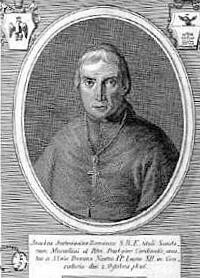
The favorites in voting at that time appeared to be Cardinals Pacca and Giustiniani [ portrait at right ]. From December 30 to January 3 the votes kept coming out the same: Pacca 13, Giustiniani 14, De Gregorio 3. According to Msgr.Dardano (Silvagni, 252), it was clear to Cardinal Pacca on the 30th that his hopes for the Papacy were not going to be realized. On the evening of the 3rd a letter, written by Giuiseppe Cardinal Albani, the Austrian agent, came to light. The letter indicated that Albani's choice for the Papacy was neither Cardinal Cappellari nor Cardinal Pacca; his letter continued that, on the next day, he intended to name Cardinal Macchi, and that the unnamed intended recipient of Albani's letter should prepare to see Macchi elected pope (Lector, 397, 496). But Macchi had only four or five votes, and reached his maximum of twelve on January 19. He was strongly resisted by the French faction.
On January 6, the morning scrutiny indicated that Giustiniani had 18 votes, which grew to 24 in the accessio (Carafa, in Petruccelli, 402).
On the 7th of January, Gustiniani's count reached 21 votes (16 on the scrutiny and 5 more at the accessio). On the evening of the 8th of January, before the second scrutiny of the day, the Veto (exclusiva) was pronounced against Giacomo Cardinal Giustiniani (Archbishop-Bishop of Imola), who was only two votes short of election, by Juan Cardinal Marco-y-Catalan on behalf of the Spanish Court (Wahrmund, 233; Berthelet, p. 38). This was not a surprise. Marco had already warned the cardinals privately as to what he would be compelled to do if they continued to advance the candidacy of Cardinal Giustiniani (Cipoletta, 208-209). Marco-y-Catalan was challenged, as to whether he was really authorized to present a veto. In reply he presented a letter, dated December 24, 1830, from Ambassador Labrador (Berthelet, 38):
Il sottoscritto ambasciatore straordinario e plenipotenziario di sua maestà Cattolica presso la Santa Sede, riverisce distintamente sua eminenza, e la prega di far presente al sacro Collegio riunito in Conclave, che egli in nome del suo augusto sovrano, e d'ordine espresso di sua maestà Cattolica, dà l'esclusione pel soglio pontificio all'eminentissimo cardinal Giustiniani.
Giustiniani, son of an English mother, had been Nuncio in Spain (1817-1827), and had supported the extreme conservatives (or absolutists), and it was perhaps he who counseled Pope Leo XII in favor of the Carlists. He was expelled from Spain by the liberal revolution, but brought back by the government of King Fernando VII.(1784-1833). Queen Maria Cristina, Fernando's fourth wife, who was aware that Giustiniani was opposed to the accession of her daughter Princess Isabella, ordered that the veto be imposed (Silvagni, 28-29). Giustiniani's nephew, Cardinal Carlo Odescalchi, the leader of the Zelanti, had known well in advance of the intended Spanish veto, but said nothing about it to his uncle.
On the 9th of January, the Cardinal Dean announced before the scrutiny that the Veto had been pronounced. Cardinal Giustiniani made a brief and dignified reply (Berthelet, 38-39). Later that day Cardinal Croy of Rouen entered conclave.
On January 11, Cardinal Cappellari received 22 votes in each scrutiny.
On the 12th of January, Cardinal Albani was engaged in correspondence again, this time with the Austrian ambassador, to discover what the Austrian Court's opinion would be on Cardinal Cappellari.
On January 15, Cardinal Cappellari had 23 votes at the scrutiny (Silvagni, 258).
On January 19, Cardinal Macchi received three votes at the scrutiny and nine more at the accessio.
SOMETHING LIKE A VETO
On January 21, Cardinal Isoard, speaking on behalf of the French Court, made it known that his government could not accept Cardinal Macchi as Sovereign of Rome. This was not a formal veto (exclusiva), announced to the Cardinal Dean and made at a scrutiny, but only a statement of preference. It was less offensive, but it had the intended effect. Cardinal Herzan had used the same technique successfully on behalf of Austria at the Conclave of 1800, twice frustrating the campaigns of two cardinals, despite the tradition that only one veto was allowed by each Crown. (Luigi Carafa, the Neapolitan agent in Rome, had already reported the likelihood of such an event on December 4: Cipolletta, 189). The reason for the French objections to Macchi appears to have been the fact that Macchi had been too close to Louis XVIII, at least according to Carafa [Petruccelli, 403].
On January 22, Cardinal Ribera of Toledo, the President of the Council of State in Madrid, arrived.
ELECTION
The answer to Cardinal Albani's request for instructions came on the 26th [Lector, 397].
A letter written on the 29th of January by the Neapolitan agent, Luigi Carafa, notes that on the forty-sixth day of the Conclave the voting results showed that the faction of Cardinal De Gregorio had 18 votes, while the faction of Cardinal Pacca had 22, and that they were locked tight in their opinions. (Cipolletta, 210-11) At that moment, De Gregorio's faction were supporting Cardinal Benvenuti. Pacca was receiving the votes of the Austrian faction, and Cardinal Albani hoped that Pacca in his advancing age would leave all of the affairs of government to him. But everyone in the Sacred College knew that Pacca would not be the pope. The issue, Carafa believes, was not so much who was going to be Pope, but who was going to be named Secretary of State. The Austrians considered it imperative to hold on to their interests in northern and central Italy, now in the face of the Risorgimento as well as the French, and it was incumbent upon Albani to produce a compliant pope. He would, of course, have liked to be Secretary of State, but he had competition in the person of Cardinal Bernetti. The faction of De Gregorio had such a strong antipathy to Albani that they actually improved Bernetti's chances. Therein lay the problem for Cardinal Cappellari. He was the frontrunner, and he was acceptable to the Austrians, but if he wished to be Pope, he would have to satisfy the Austrians that he would appoint the right sort of Secretary of State to carry out a pro-Austrian foreign policy. But Cappellari's friend and one of his campaign managers, Cardinal Testaferrata, to whom he had promised the position, was not acceptable to the Austrians [Petruccelli, 405-408]. Finally, it seems, Cappellari agreed to appoint a conservative and a friend of Austria.
Mauro (Benedetto) Cardinal Cappellari, OSB Camald., was elected Pope Gregory XVI on February 2, on the 83rd ballot:
Questa mattina è eseguita l' elezione del Papa in persona del Card. Cappellari, che ha preso il nome di Gregorio XVI. L' elezione, che pare fosse combinata ieri sera è stata fatta con 32 voti (cioè con due di più del nesessario) allo scrutinio. [Chigi Diary]
There were still seven votes for Pacca, three for De Gregorio, two for Galleffi, and one for Gazzola.
BIBLIOGRAPHY
On the revolutionary political events of 1830-1831, see Friedrich Nippold, The Papacy in the 19th Century (New York 1900) pp. 83-94; Gioacchino Vicini, La rivoluzione dell' anno 1831 nello stato romano (Imola 1889); and Antonio Vesi, Rivoluzione di Romagna del 1831 (Firenze 1851).. On the death of Pius VIII, see the letter of Luigi Carafa to the Prince of Cassari (November 30, 1830), quoted in Eugenio Cipolletta, Memorie politiche sui conclavi da Pio VII a Pio IX (Milano 1863), pp. 177-178; and on the early voting, p. 196; on the Spanish Veto, p. 206-208. Ludwig Wahrmund, Das Ausschliessungs-recht (jus exclusivae) der katholischen Staaten Österreich, Frankreich und Spanien bei den Papstwahlen (Wien: Holder 1888), 233.
For a view of a well-placed observer (deriving material from Cardinal Weld and his conclave Secretary, Bishop Riddell), see Nicholas (Cardinal) Wiseman, Recollections of the Last Four Popes (London 1858) 416-419. F. Petruccelli della Gattina, Histoire diplomatique des conclaves Volume 4 (Paris: 1866) 392-422. Monsignor Pietro Dardano (1791-1870) was present at the conclave, as conclavist of Cardinal Giuseppe Morozzo di Bianzè, and left a diary: David Silvagni, "Diario dei conclavi del 1829 e del 1830-31 di Mons. Pietro Dardano," Rivista europea 14 (Firenze 1879), 5-29; 249-271 [containing a chart of all the votes cast]. David Silvagni, La corte e la societa romana nei secoli XVIII e XIX Volume Terzo (Roma 1885), 428-460. Giovanni Berthelet, Conclavi, Pontefice e Cardinali nel Secolo XIX (Torino-Roma 1903),
Eugenio Cipolletta, Memorie politiche sui conclavi da Pio VII a Pio IX, compilate su documenti diplomatici segreti (Milano: Legros e Marazzani 1863), 175-214. Lucius Lector [pseudonym of Msgr. Joseph Guthlin], Le conclave (Paris 1894) 605-607. Christopher Korten, The Making of a Pope: How Mauro Cappellari became Pope Gregory XVI (1765-1831) (Oxford dissertation 2006) [non vidi].
Charles Baille, Le Cardinal de Rohan-Chabot, Archevêque de Besançon (1788-1833) (Paris: Perrin 1904).
On the plight of the Church in France: P. Feret, "Les Ordonnances de 1828: Le gouvernement, L' église de France, Le Saint-Siège," Revue des questions historiques 38 (1904), 539-579. Adrien Le Clerc (editor), L' ami de la religion. Journal ecclésiastique politique et littéraire 66 (Paris 1831) [The official news from Rome is translated from the Diario di Roma].